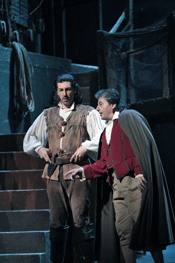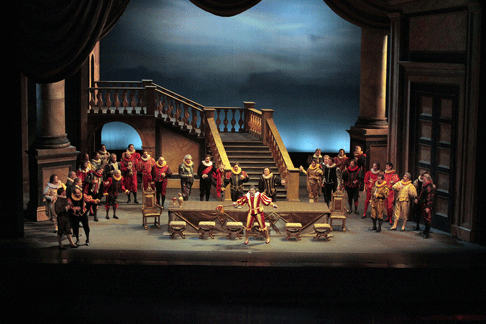01 Apr 2009
Rigoletto at San Diego Opera
In the current weak economy many an opera company has retrenched its programming to present primarily the most popular operas.

In the current weak economy many an opera company has retrenched its programming to present primarily the most popular operas.
Think of it as operatic comfort food, if you will, in stomach-rattling times. San Diego Opera seems to have gone further, deciding to present its operas in stagings that can remind its audiences of long past high-rolling days.
Ian Campbell at San Diego Opera apparently discovered a secret trove of older New York City Opera productions, entirely traditional and only faintly musty. Spare but practical settings of Il Barbiere di Siviglia and Maria Stuarda were used in recent seasons, and the program for this season’s Rigoletto offers the vague credit “Scenery and costumes created for New York City Opera.” Elsewhere Carl Toms is identified as the creator, but no year is provided.
It looks to be from the mid-1970s, possibly early 1980s. Scene one of act one gets a handsome setting, with a palatial staircase dominating the picture, along with an oversized statue of an unidentified royal figure. The back opens to a deep view of a nighttime sky, which might get a little chilly for the attendees of the Duke’s get-together but adds to the atmosphere. A very lengthy scene change produced a less impressive set for scene two, with Rigoletto’s quarters being not much more than an iron gate and a staircase to an off-stage residence. This configuration returns to the stage the convention of characters using a gate when they could just step around it. Act two, supposedly the Duke’s private apartment, simply removed the statue from the act one set. Act three, tricky to stage with its action in the inn combined with positions for Gilda and Rigoletto to eavesdrop, as well as a riverbank locale, came off fairly well, if looking a bit like something from the old Disneyland Pirates of the Caribbean ride. The evening’s one innovation came across as superfluous, if not baffling: brief title screens, as if from a silent film, appeared before each curtain, mostly declaring that Rigoletto is an evil figure - arguable but still an odd framing device.
 Arutjun Kotchinian as Sparafucile and Lado Ataneli as Rigoletto
Arutjun Kotchinian as Sparafucile and Lado Ataneli as Rigoletto
Lotfi Mansouri is just the director for such a production, as he favors the stock gesture and routine stage movement. For a tenor such as Giuseppe Gipali, the Duke, the result was a stiff, uncharismatic performance. And Gipali does not have the voice to excuse such dramatic weakness. His tenor refuses to project unless at the very top of his range, and it possesses no interesting colors. L’ubica Vargicová, however, revealed a keen identification with the character of Gilda, evoking her innocence and faith without seeming weak or foolishly deluded. Even better, Vargicová sings beautifully, managing the trickier parts with no evident effort (she is also a successful Queen of the Night), and dominating many ensembles with her penetrating sound. It wasn’t always beautiful, but it was mostly exciting, and the San Diego audience greeted her passionately at final curtain.
Lado Ataneli has not proven himself in the past to be a captivating performer, but his dark baritone is a top class instrument. He really gave himself completely to this role, and if he had been in a production with a bit more imagination, he could have had even more impact. At least vocally, however, he could dominate most scenes, and the end of act two, in the duet with Gilda, became the highlight of the evening.
 A scene from Rigoletto
A scene from Rigoletto
Ian Campbell cast the rest of the opera from strength, with a very sexy Kristin Chavez as Maddalena, and the truly scary, rail-thin Sparafucile of Arutjun Kotchinian, his bass oozing out of him. Malcolm Mackenzie stood out in his brief appearances as Marullo, unctuous and self-satisfied, as did the tragic Monterone of Scott Sikon.
The capable Edoardo Müller did his usual efficient work with the orchestra, although the act three quartet lacked punch and cohesiveness.
The program featured photographs of previous San Diego Rigoletto productions, and the 2002 snapshots revealed a fresh, updated approach. Either it was a failure at the time, or Campbell just decided that staging is not what his audience is currently in the mood for. Which is fine, but traditional stagings need fresh approaches as well. Despite the fine work of Ataneli and Vargicová, some cobwebs remained on the set by the end of the evening.
Chris Mullins